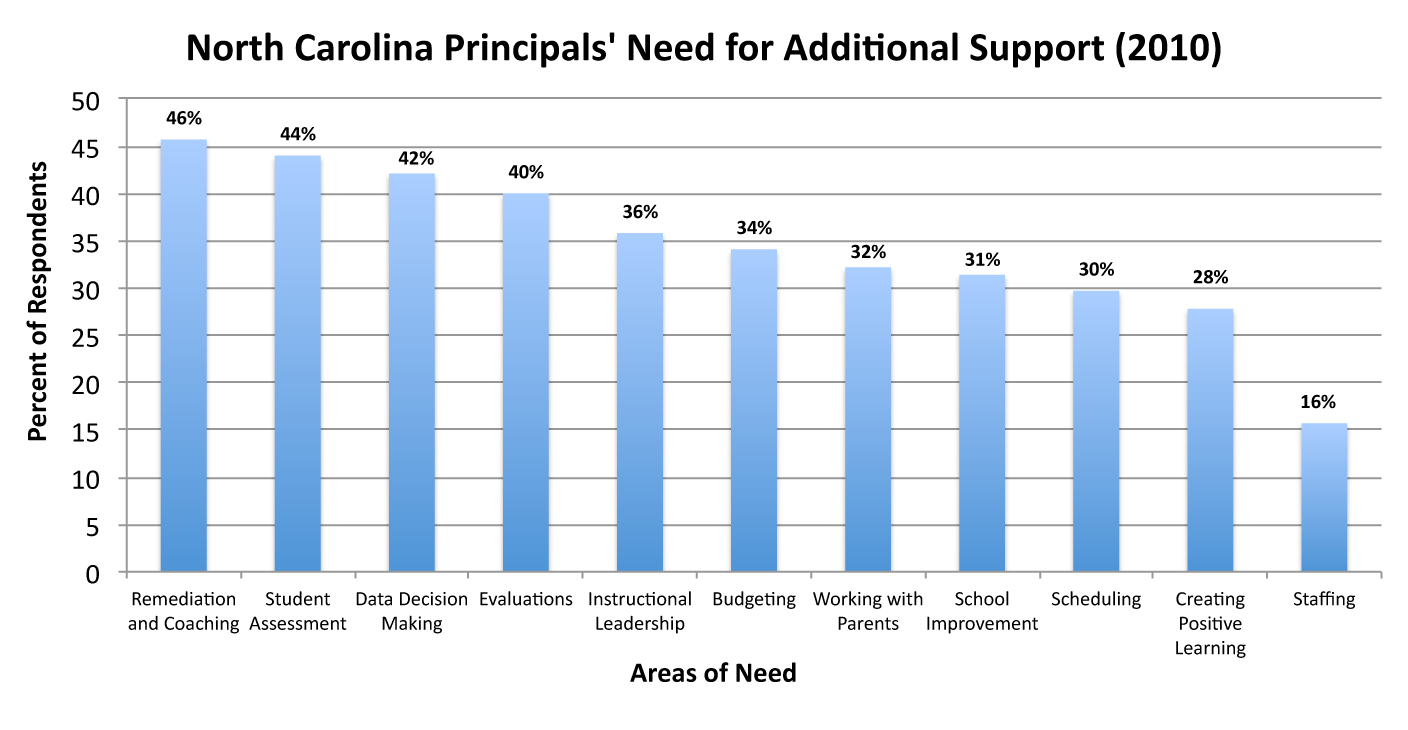What areas do principals express as needing additional support?
Why is this question important? Researchers can use surveys to identify areas in which principals believe they are need of additional support. These surveys can also help guide future researchers propose studies to answer questions on how to effectively design school principal's duties that can have the biggest impact on student achievement.
See further discussion below.

Results: New requirements from policy makers including accountability measures have added to an already heavy principal list of responsibilities. New roles derived from research: formative assessment (Yeh, S. S. (2007), teacher coaching (Joyce & Showers, 2002), instructional leadership (Robinson, Lloyd, & Rowe, 2008) and teacher feedback (Kluger & DeNisi, 1996) have also added to the stress felt by principals. Principals in the survey confirm this feeling of being overwhelmed by the workload when they report not having sufficient time to do all that is required of the job.
Remediation and coaching, student assessment, data-based decision making, instructional leadership, and evaluation of personnel top the list of needs expressed by principals and are reflective of the new responsibilities recommended by research.
A significant number of principals (33 percent) felt the district had not done enough to reduce the time required for administrative duties the principals believed to be less relevant and to allow them more time to focus on instructional leadership issues (coaching, data analysis, and professional development).
And finally, principals overwhelming (84 percent) report their own professional development was a priority in order to provide them with the skills to be successful in instructional leadership and other mission critical areas, but fewer (73 percent) felt they had the sufficient resources to meet this pressing need.
Implications: Over the past twenty years the role of the principal has expanded and grown in complexity as new duties and roles have been added to the job description (Burkhauser, Pierson, Gates, & Hamilton, 2012; Scheerens, 2012). In response principals are asking for more training, time, and resources to meet these new challenges. Because of the pivotal role principals play (Hattie, 2009 in student success, additional research is required to translate our current knowledge base on the job of the principal into practical ways for principals to master and then manage the complex operation of a school.
This research also has implications for the future design of principal preparation programs and on-the-job coaching and development of principals that can maximize the success of teachers and students. And finally, this information should act to stimulate an examination of organizational designs that move away from the heroic principal model, in which the principal is the expert of an large number of difficult skills, to organizational models that provide the principal with resources and new means to utilize current resources to meet the new standards.
Study Description: The North Carolina Working Conditions Survey included two years of educator data, 2008 and 2010. It represents 105,688 educators from school districts and traditional schools in the state of North Carolina and represents an 89 percent response rate from the state's educators. 2,100 principals were included in the principal portion of the survey. The principals were asked questions about working conditions. The questions examined issues of; roles principals play in running an effective school, establishing school policies, providing school leadership, and implementing school improvement plans.
Definitions: Heroic principal model: This model of school management relies on the principal to be competent and inspirational in a wide range of complex skills that include but are not limited to: Instructional leadership, staff supervision, data-based decision making, student assessment, performance management, budgeting, public relations, parent relations, facilities, regulation compliance, staff development, and curriculum.
Citation:
Burkhauser, S., Pierson, A., Gates, S., and Hamilton, L. (2012) Assessing the Relationship Between Administrator Preparation Programs and Job Performance. Rand Corporation.
Hattie, J. (2009). Visible learning: A synthesis of over 800 meta-analyses related to achievement. New York: Routledge.
Joyce, B. R., and B. Showers (2002). Student Achievement Through Staff Development, Alexandria, VA: Association for Supervision and Curriculum Development (ASCD) Books.
Kluger, A. N., & DeNisi, A. (1996). The effects of feedback interventions on performance: A historical review, a meta-analysis, and a preliminary feedback intervention theory. Psychological Bulletin, 119(2), 254-284.
Scheerens, J. (2012). Summary and conclusion: Instructional Leadership in schools as loosely coupled organizations. In School Leadership Effects Revisited (pp. 131-152). Springer Netherlands.
* New Teacher Center (2010). North Carolina Teacher Working Conditions Survey: Principal Working Conditions. New Teacher Center. Retrieved October 9, 2014 from http://2012.ncteachingconditions.org/sites/default/files/attachments/NC10_brief_Principals.pdf
Robinson, V. M. J., Lloyd, C. A., & Rowe, K. J. (2008). The impact of leadership on student outcomes: An analysis of the differential effects of leadership types. Educational Administration Quarterly, 44(5), 635–674. Originally published online September 23, 2008. Retrieved October 5, 2011, from http://eaq.sagepub.com/content/44/5/635.full.pdf
Yeh, S. S. (2007). The Cost-Effectiveness of Five Policies for Improving Student Achievement, American Journal of Evaluation, 28(4), 416–436.
* study from which graph data was derived
